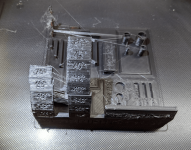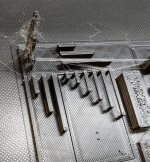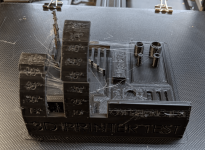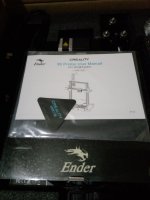Bicycle Helmets for Rounder Heads
Summary: This page is for those who have rounder head shapes and find most helmets made for the US market too squared off inside to be comfortable.
Heads have different shapes. There are individual variations and types. The world's rounder heads seem to be found among Asian peoples. A helmet made for the Japanese market has to be configured differently inside than those normally sold in the US or in Europe. It will feel uncomfortable on most Caucasian heads. Although the dimensions from front to back and side to side are about the same, there are ridges in different places that have to be accommodated. Many Americans of Asian extraction find it difficult to find a good fit in the US market. Using a typical US brand helmet forces the user with an Asian head shape to install thick pads to compensate for lateral ridges, forcing a too-large helmet.
In May of 2021 Trek announced a new round fit version of their Starvos WaveCel model. It is being marketed in the US. Trek's description: "Round Fit sizing designed to accommodate rounder head shapes." The retail price is $100.
One obvious solution for a rider with a round head is to buy a helmet made for Japan. That may be more difficult than it should be, since Japan does not have the easy internet and mail order options that US retailers offer. And long-distance fitting seldom works out as well as putting the actual helmet on your own head and trying it. The Japanese Bicycle Federation JBF helmet standard actually requires that the helmet have a round head fit, so if you find a helmet meeting it you will have found a round helmet. Unfortunately, JFB-certified helmets are not likely to offer enough protection to pass the US CPSC standard.
One rider of Asian parentage shared with us his internet research. "While looking for helmets on Amazon Japan, I read that people have been able to buy products in Japan and have them shipped to the US using a forwarding service called Tenso. I was able to buy OGK Kabuto Steair-X which fits my head perfectly. OGK Kabuto makes a few helmets for large heads and since these helmets are made for the Japanese market they also fit round heads well." Another rider bought an OGK Kabuto Zenard XXL and it fit his very large round head, as did all OGK Kabuto XL and XXL models. The same rider fit well into a Kask Mojito X-Large.
In January of 2020 a rider asked Giro and was told they did make Asian Fit for their Aether, Synthe, and Syntax helmets. But there are no US retailers selling them, so they may not meet the US standard. This rider found an Ebay listing by a South Korean seller for the Giro Aether.
Another rider with a round head contributed these links to Japanese sites:
Smith (the red circular dot indicates the "Asian Fit" models). One rider who asked Smith about their helmets was told that the outer shell is the same as US models, but the pads are shaped for Asian heads.
Specialized
Bontrager has Asia Fit versions of the Ballista, the Velocis, the Circuit, and the Solstice in addition to the XXX (their customer service told me that they have no plans to offer a variant of the Specter at the moment, sadly. See below)
Lazer (The "AF" in the product name stands for Asian Fit. There are no MIPS versions?)
Bontrager (Trek) has an Asia Fit model of their XXX WaveCel available in Japan for rounder Asian heads. The WaveCel models scored high in Virginia Tech's testing for low impact and concussion protection. They are written up on our Helmets for 2019 page. We don't know if US Trek stores can get them or not. Trek also sells the Bontrager Specter WaveCel in Japan, but it is the same helmet sold in the US, so apparently riders select a size larger for their wider head.
One cyclist emailed that they found Japanese helmets on the Japanese Amazon site. Some of them say they are certified to the CPSC standard. But the cyclist had to have the helmet forwarded through Tenso anyway.
In the US market, there is no helmet we know of that is designed for rounder heads. Specialized has one model, the Contour, that is marketed in Japan and made for Asian heads, but they don't sell it in the US. It is based on the Specialized Align model, but it is not an adapted US helmet. It is made in a different mould that is shaped for Japanese heads. We received an email in 2012 from the owner of an Asian head saying he found the Specialized Covert, a similar helmet to the Contour, fitted his head well. He had tried on no less than 50 other helmets that did not. We received another email confirming that in January, 2013, saying "Got the large and I have not had a helmet fit so well in about 10 years! Previous XXL large helmets would not even go down on my head, so this was huge improvement." We have heard from at least two riders with a very large Asian head that the Louis Garneau Arcterus fitted them better than any of the other super-sized models. In 2015 a Singapore resident told us he found that the Specialized Tactic II fitted his head well. But you may have to buy in Asia or Japan to get the round head fit. In 2020 another rider emailed that he has tried the US version of the POC Coron Air Spin (full face mountain helmet) and it fit his round head well.
Four European manufacturers: Bell (their Euro line), Bern, Cratoni, Kask and Selev, have models that they inform us will fit rounder heads better, but we don't have any feedback from users on that yet. Bern has a special pad kit they call the "Japan Fit" kit with top pads and inserts that convert their models to fit rounder heads. It can be ordered directly from Bern. Check them out on our Helmets for This Season page. In 2015 Kask added their Mojito XL, the only Asian-fit helmet for up to 64cm (25.2") heads. In 2019 Bell has the Aeon, Savant, Sonnet, Revel, Verona and Raze. All are certified to the European standard, not CPSC, so are not available in the US.
In the UK there is hope for rounder-headed riders if you want an actual custom-fitted helmet manufactured to fit your own head. HEXR is scanning heads with iPads and manufacturing custom helmets with 3d printers. They meet the EN1078 European helmet standard. See this section of our Helmets for 2020 page for more info. The concept of scanning heads at home offers promise for fitting helmets of all types, even off-the-shelf models.
In the distant past, one manufacturer with a unique design claimed that their helmet accommodated rounder heads better because it was made with flexible chunks of foam joined together by internal mesh, and the foam panels can move slightly to accommodate to different head shapes. Here is our writeup on that helmet, the SportScope, for the 2001 season. It has disappeared from the market in subsequent years, but you may find a dusty one around somewhere, or be able to locate it online. In 2013 Bell reintroduced the concept, but with a solid outer shell and segmented foam pieces in the liner. The model is called the Segment, but we have no reports on how well it fits rounder heads.
In 2011, the Swiss company TSG introduced their Kraken model, based on the same type of segmented foam liner that the Sportscope used. You can read about it on our Helmets for 2011 page or on TSG's web page.
Another approach that may work for rounder heads is the "one size fits all" helmet that has what we call a ring fit system. The helmet fits by adjusting a ring around the head. The pieces that attach the ring to the helmet are often adjustable, and you may find one that can accommodate your head shape. Unfortunately we don't know which brand or model would be best.
If you are forced to make your round head fit in a square helmet, the best alternative will be to use the fitting pads that come with the helmet, or extra fitting pads, to try to achieve a rounder shape. Cratoni informed us some years back that they were selling the same helmets in the US and in Asia just by including their "Asian fit pads" when they ship helmets to Asia. They were not selling their Asian pads separately, but that indicates that the pad solution is possible if you are willing to fiddle with it. Extra fit pads are usually available at bike shops. Or you can add other foam from somewhere else if it works for you, since its role is to stabilize the helmet on your head and add comfort, and the fitting foam is not part of the helmet's impact protection.
Denting or shaving down the inside of the stiff foam liner to make the helmet fit you would reduce your protection, so that would not be an optimal choice. Better to buy a larger size and add pads to the front and back. Experimenting with fit pads is probably your best bet, even though it will be a fussy process.
If you find a better way, a source of Asian fit pads, or a formula for the use of the pads, please contact us so we can add it to this page.
For general fitting instructions, see our page on fitting helmets..
If you need to find out what your size is, check this page.
 How is it for sucking up water? Mine came not vacuumed packed. Currently I'm keeping it in a good brand gal. sized baggie w/desiccant.
How is it for sucking up water? Mine came not vacuumed packed. Currently I'm keeping it in a good brand gal. sized baggie w/desiccant. That's ok, it just gives me an excuse to order more in different colors. I also think I will be looking for better fittings that hold the tube on.
That's ok, it just gives me an excuse to order more in different colors. I also think I will be looking for better fittings that hold the tube on.







